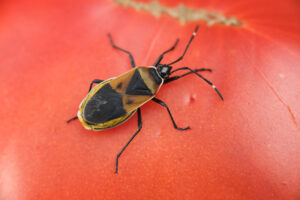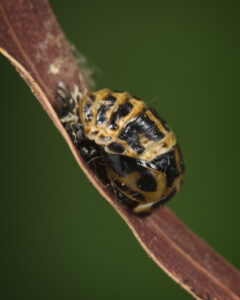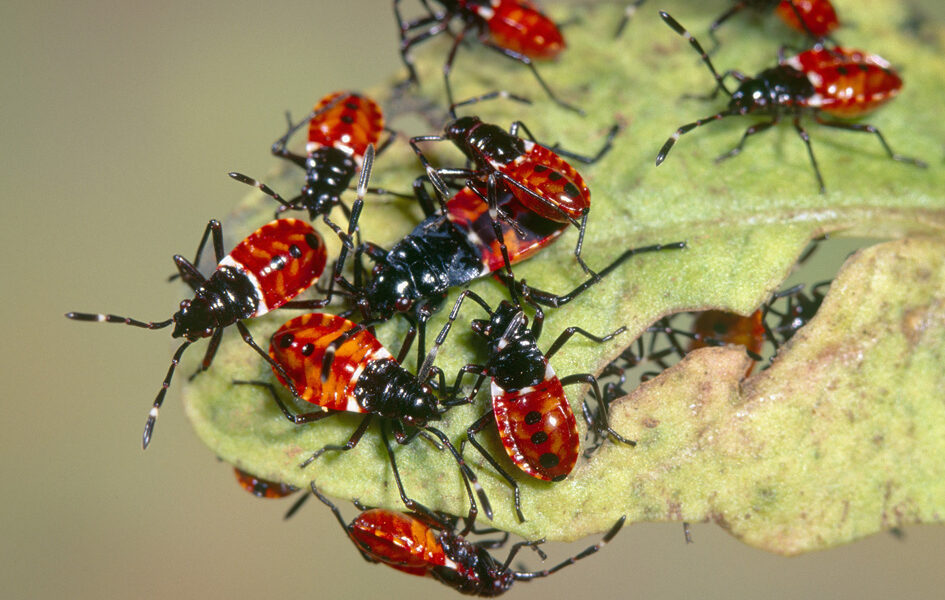Understanding insect life cycles
By Denis Crawford
There is more than one type of insect life cycle. Understanding the life cycles of insects can help when managing pests and/or encouraging beneficial insects.

In Pest Files of April this year I described the insect life cycle of ‘complete metamorphosis’ or holometabolous development, from egg to larva to pupa to adult. Insects which demonstrate complete metamorphosis include lacewings (Neuroptera), beetles (Coleoptera), flies (Diptera), moths and butterflies (Lepidoptera), and ants, bees, and wasps (Hymenoptera).
The word ‘metamorphosis’, comes from the Greek words meta (change) and morphe (form). The word ‘holometabolous’ comes from the Greek words holos (entire) and metabole (change). Therefore, metamorphosis means a change of form, and holometabolous (or complete metamorphosis) means an ‘entire change of form’. That change is referring to the immense change from the larval form to the adult form via the pupal stage. When you put a larva next to an adult of the same species they look like completely different animals.
The other common insect life cycle is one of ‘incomplete metamorphosis’ or hemimetabolous development. Insects such as dragonflies and damselflies (Odonata), grasshoppers (Orthoptera), earwigs (Dermaptera), cockroaches and termites (Blattodea), and bugs (Hemiptera) have hemimetabolous life cycles. The term ‘hemimetabolous’ comes from the Greek words hemi (half) and metabole (change). The lifecycle is typically egg to nymph to adult. The ‘change’ is that of the final stage nymph to a winged adult.
These two main lifecycles detailed above have something in common. The only time insects grow is during their immature stages i.e., at the larva or nymph stage. Once an insect reaches the adult stage it does not grow. The pupal stage of the holometabolous life cycle is a transformation stage rather than a growth stage.
So how do does this knowledge help us manage pest insects or encourage beneficial insects? For a pest insect, we need to know which life stage(s) is likely to cause the most damage to plants. For a beneficial insect we need to know which life stage(s) is likely to be beneficial e.g., as a pollinator or a predator etc.
Let’s start with holometabolous pests. There are two stages of this life cycle where the insect doesn’t feed – the egg stage and the pupal stage. If we look at a caterpillar pest such as the cabbage white butterfly (Pieris rapae), the only stage that damages plants is the larval stage. That is the life cycle stage we want to interrupt. The adult butterfly is a harmless nectar feeder but lays eggs directly onto its larval food plants, brassicas. Larvae grow to full size on their food plants, feeding all the while, and pupate on or near the plants. We could keep an eye on our brassica plants for eggs and apply a biological insecticide such as Dipel as soon as the larvae hatch, or we could prevent egg lay completely by netting plants. Waiting until larvae reach full size is not advisable – they consume 90% of the food they will ever eat in their final instar.

(Supplied by Denis Crawford of Graphic Science)
Some holometabolous pests damage plants at the larval stage and the adult stage, for example weevils. Garden weevil (Phylctinus callosus) is an introduced flightless pest which feeds on many plants including ornamentals, fruit trees, vegetables, grapevines and a range of broadleaf weeds. Female weevils lay their eggs in organic matter, such as mulch and leaf litter, in summer and autumn. Larvae hatch and burrow into the soil to feed on plant roots, where they develop during winter. They pupate in the soil and, after a few weeks, emerge as adults to feed at night. Feeding damage from adult weevils is first seen on the lower leaves and, later, on leaves higher up the plant. Weed control reduces available breeding and feeding sites. Home gardeners can pick weevils off plants at night. Weevil pupae are soft and vulnerable, and some Victorian vineyards have successfully reduced weevil numbers by rotary hoeing between rows. The fact that the adult weevils can’t fly can be used against them and sticky bands around plant stems prevents adults climbing into plants to feed on foliage.
Pests with hemimetabolous life cycles, such as the Australian plague locust (Chortoicetes terminifera) which is found through most of Australia, and the harlequin bug (Dindymus versicolor) of south-eastern Australia, don’t have a pupal stage. These insects can damage plants right through their life cycle once they have hatched from eggs. Although they are completely different insects, in that one chews plants (the locust) and the other is a sap-sucking pest (the bug), they have something in common. Their nymphs congregate together in their early instars. Clusters of plague locust nymphs are targeted with biological insecticides. Clusters of harlequin bug nymphs can be knocked off plants into a bucket of soapy water, or that part of the plant can be pruned off. In either case, waiting until the adult stage to take action makes controlling the pest more difficult… they can fly after all.

With holometabolous beneficial insects it’s important to know what the immature forms look like so they are not inadvertently ‘controlled’. Like all holometabolous insects, the larvae of hover flies look nothing like their fly parents, they are maggots. It’s a bit of a stretch for some people to accept maggots on their plants, but hover fly larvae are voracious predators of aphids. We should also keep an eye out for lacewing larvae and ladybird larvae on plants because they are also important predators. Unfortunately, they are sometimes mistaken for pests. Do you know what a ladybird beetle pupa looks like? They are often found stuck to the same plant they have been hunting for prey on – we have printed an image here.
Hemimetabolous beneficial insects such as damsel bugs and mantids are easier to identify in the juvenile form as they are miniature versions of the adult form. As soon as they hatch from eggs these predators are searching for prey to feed on, and they continue doing so through all their immature stages (nymphs) and their adult life. There is no non-feeding pupal stage like with holometabolous insects.
The take-home message is that learning about the complete life cycle of an insect can help with pest management and the encouragement of beneficial insects. Whatever you do to control sap-sucking pest insects such as harlequin bugs, or leaf-chewing caterpillar pests, will be more effective earlier in their life cycle than later. Knowing what beneficial insects look like in their immature forms enables us to protect and encourage them.
Main photo: Sap-sucking harlequin bugs cluster together as early-stage nymphs (Supplied by Denis Crawford of Graphic Science)

